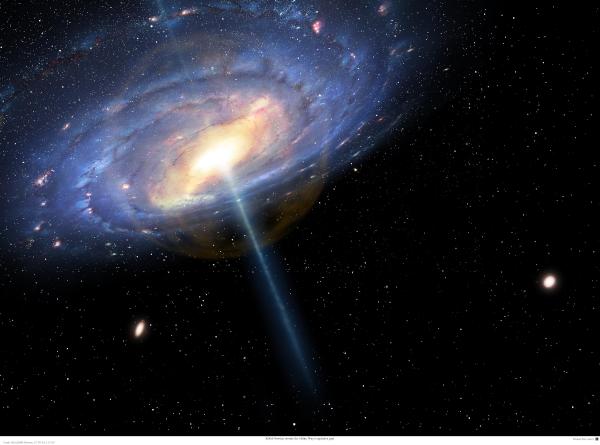XMM-Newton reveals the Milky Way's explosive past

Minimum credit line: Image courtesy of Mark A. Garlick (CfA) and ESA. (for details, see Conditions of Use).
Credit: ESA/XMM-Newton, CC BY-SA 3.0 IGO
The image above can be displayed at full size and may be downloaded by clicking the image above.
| About this Image |
|---|
Artistic representation of our Milky Way galaxy during an active phase. While a small fraction of distant galaxies contains an active core (known as Active Galactic Nucleus, AGN), the central black hole in our own Galaxy is silent and dark. This may not always have been like this, and the artist impression illustrates how the Milky Way may have looked like some 6 million years ago. XMM-Newton delivered strong evidence for this scenario by finding a low-density bubble within a radius of 20 000 years around the galactic centre that can be caused by an AGN whose activity snow-ploughed through the halo gas, opening up the bubble.
Investigator(s): Fabrizio Nicastro
| For More Information |
|---|
- Read the Press Release
- Read the Journal article
- Detailed description of this image
- Query XSA archive for XMM-Newton data in the field of Milky Way
- For unfamiliar terms, visit the XMM-Newton Astronomical Glossary
| Instrument | EPIC pn | ||
| Observing Mode | Full Frame | ||
| Filter | Thin | ||
| Image size | 0.00 x 0.00 arcsec | ||
| Detailed Caption | Astronomers know that there is a supermassive black hole at the centre of our Galaxy. It lies silent and dark these days, but when looking out into the wider Universe, astronomers see that a small percentage of galaxies contain an extremely bright core. These cores are called active galactic nuclei, and our own Milky Way may once have had one of them. A thorough analysis of archival XMM-Newton observations has shown that there is a vast quantity of baryonic matter scattered through the Milky Way in the form of gas at a temperature of one million degrees that permeates both the disc of the Galaxy, where the majority of the stars are found, and a spherical volume that surrounds the whole Galaxy. The density of gas should be at its peak in the centre of the Galaxy but the archive study has now shown that the peak density is in fact away from the centre of the Galaxy, leaving a bubble of lower density within a radius of about 20 000 light years from the Galaxy's centre. This radius of the high-density peak coincides with the size of two large 'balloons' of gamma rays found in 2010 by NASA's Fermi gamma-ray observatory, which extend tens of thousands of light-years above and below the centre of our Galaxy. This means that something had pushed the gas outwards from the centre of the Galaxy, creating a giant bubble, providing strong evidence that the central black hole was much more active some six million years ago, pulling stars and gas clouds to pieces and swallowing the contents. En route to annihilation, the doomed matter was heating up and releasing vast quantities of energy that snow-ploughed through the halo gas, opening up the bubble. | ||
| Alternate Resolutions | (Help) |
|---|
This image is available in the following downloadable versions: Higher resolution versions of this image may be available, please contact the XMM-Newton HelpDesk.
Search the Image Gallery
To search the Image Gallery for a particular object, fill in the object name in the box below and click the Submit button.To search the Image Gallery for other images, fill in any of the fields below and click the Submit button.
For more search options, please use our Advanced Search form.